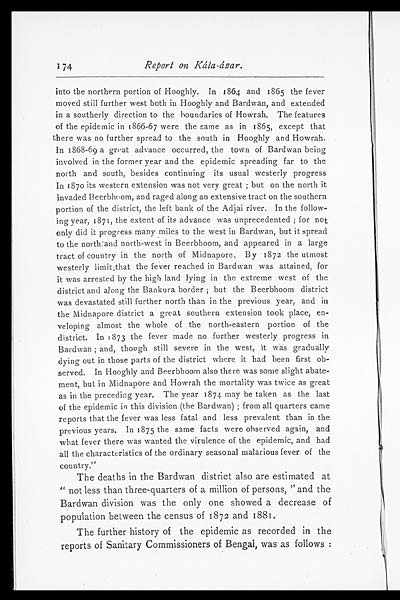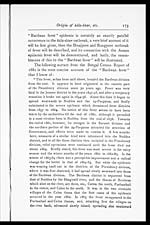Medicine - Institutions > Army health reports and medical documents > Report of an investigation of the epidemic of malarial fever in Assam, or, kala-azar > Section VIII - Origin of kala-azar and its resemblance to the "Bardwan fever" epidemic
(202) Page 174
Download files
Individual page:
Thumbnail gallery: Grid view | List view

174
Report on Kála-ázar.
into the northern portion of Hooghly. In 1864 and 1865 the fever
moved still further west both in Hooghly and Bardwan, and extended
in a southerly direction to the boundaries of Howrah. The features
of the epidemic in 1866-67 were the same as in 1865, except that
there was no further spread to the south in Hooghly and Howrah.
In 1868-69 a great advance occurred, the town of Bardwan being
involved in the former year and the epidemic spreading far to the
north and south, besides continuing its usual westerly progress
In 1870 its western extension was not very great; but on the north it
invaded Beerbhoom, and raged along an extensive tract on the southern
portion of the district, the left bank of the Adjai river. In the follow-
ing year, 1871, the extent of its advance was unprecedented; for not
only did it progress many miles to the west in Bardwan, but it spread
to the north and north-west in Beerbhoom, and appeared in a large
tract of country in the north of Midnapore. By 1872 the utmost
westerly limit that the fever reached in Bardwan was attained, for
it was arrested by the high land lying in the extreme west of the
district and along the Bankura border; but the Beerbhoom district
was devastated still further north than in the previous year, and in
the Midnapore district a great southern extension took place, en-
veloping almost the whole of the north-eastern portion of the
district. In 1873 the fever made no further westerly progress in
Bardwan; and, though still severe in the west, it was gradually
dying out in those parts of the district where it had been first ob-
served. In Hooghly and Beerbhoom also there was some slight abate-
ment, but in Midnapore and Howrah the mortality was twice as great
as in the preceding year. The year 1874 may be taken as the last
of the epidemic in this division (the Bardwan); from all quarters came
reports that the fever was less fatal and less prevalent than in the
previous years. In 1875 the same facts were observed again, and
what fever there was wanted the virulence of the epidemic, and had
all the characteristics of the ordinary seasonal malarious fever of the
country."
The deaths in the Bardwan district also are estimated at
"not less than three-quarters of a million of persons," and the
Bardwan division was the only one showed a decrease of
population between the census of 1872 and 1881.
The further history of the epidemic as recorded in the
reports of Sanitary Commissioners of Bengal, was as follows:
Set display mode to: Large image | Zoom image | Transcription
Images and transcriptions on this page, including medium image downloads, may be used under the Creative Commons Attribution 4.0 International Licence unless otherwise stated. ![]()
| Permanent URL | https://digital.nls.uk/75014855 |
|---|




